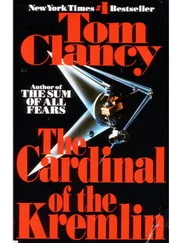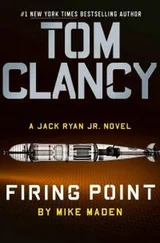Tom Clancy - Locked On
Здесь есть возможность читать онлайн «Tom Clancy - Locked On» весь текст электронной книги совершенно бесплатно (целиком полную версию без сокращений). В некоторых случаях можно слушать аудио, скачать через торрент в формате fb2 и присутствует краткое содержание. Год выпуска: 2011, ISBN: 2011, Жанр: Триллер, на английском языке. Описание произведения, (предисловие) а так же отзывы посетителей доступны на портале библиотеки ЛибКат.
- Название:Locked On
- Автор:
- Жанр:
- Год:2011
- ISBN:9781101566466
- Рейтинг книги:3 / 5. Голосов: 1
-
Избранное:Добавить в избранное
- Отзывы:
-
Ваша оценка:
- 60
- 1
- 2
- 3
- 4
- 5
Locked On: краткое содержание, описание и аннотация
Предлагаем к чтению аннотацию, описание, краткое содержание или предисловие (зависит от того, что написал сам автор книги «Locked On»). Если вы не нашли необходимую информацию о книге — напишите в комментариях, мы постараемся отыскать её.
Locked On — читать онлайн бесплатно полную книгу (весь текст) целиком
Ниже представлен текст книги, разбитый по страницам. Система сохранения места последней прочитанной страницы, позволяет с удобством читать онлайн бесплатно книгу «Locked On», без необходимости каждый раз заново искать на чём Вы остановились. Поставьте закладку, и сможете в любой момент перейти на страницу, на которой закончили чтение.
Интервал:
Закладка:
In an office beyond, Clark lifted the phone and dialed the number he’d just memorized. “Come on! Come on!”
After two rings, he heard a click and knew the call had been put through.
At that moment the six armed hunters appeared in the doorway to the office.
Clark spoke loudly into the phone: “Fabrice Bertrand-Morel, Paul Laska, and Valentin Kovalenko of the SVR.” He said it again as the men closed on him, then he hung up the phone.
The biggest man of the crew lifted his handgun high over his head, then brought it down hard onto the bridge of John Clark’s nose.
And then everything went black.
Clark awoke tied to a chair in a dark room without windows. His face hurt, his nose hurt, and his nostrils seemed to be full of bloody gauze.
He spit blood on the floor.
There was only one reason he was still alive. His phone call had confused them. Now these men, their boss, and their employer would all be scrambling to figure out whom he had communicated with. If they killed him now, after he’d passed the information on, it would do them no good.
Now they might beat him to get him to reveal his contact, but at least they would not put a bullet in his brain.
Not yet, anyway.
70
The Baikonur Cosmodrome, located north of the Syr Darya River in the steppes of the former Soviet satellite state of Kazakhstan, is both the oldest and the largest spaceport on earth. The entire grounds of the facility are roughly a circle some fifty miles in diameter, containing dozens of buildings, launch pads, hardened silos, processing facilities, tracking stations, launch control buildings, roads, an airfield, and a train station. The nearby town of Baikonur has its own airport and another rail station is nearby in Tyuratam.
The first rocket launch pad was built here in the 1950s at the start of the Cold War, and from here in Baikonur, Yuri Gagarin launched to become the first man in space. The commercial space industry would not exist for another thirty years, but today Baikonur is Russia’s main hub of private commercial space operations. They rent the property out from Kazakhstan, paying not in dollars or rubles or euros, but in military equipment.
Georgi Safronov had been walking the halls, standing on the pads, driving trucks across the steppes here for nearly twenty years. He was the face of the new Russia when it came to outer space, not unlike Gagarin himself representing Russia’s space operations a half-century earlier.
On his first day back at Baikonur, the day before the planned launching of the first of three Dnepr rockets in quick succession, forty-five-year-old Georgi Safronov sat in his temporary office in the LCC, the launch control center, situated some five miles west of the three launch silos devoted to Dnepr launches at Baikonur. The Dnepr area, though it encompassed dozens of square miles of territory, was actually quite small when compared with the launch facilities for the Soyuz, Proton, and Rokot systems in other parts of the Cosmodrome.
Georgi looked out his second-floor window at a light snowfall that obscured his view of the launch sites in the distance. Somewhere out there three silos already contained hundred-foot-tall headless rockets, but soon they would have their heads, and those three frozen concrete holes out there would become the most important and most feared place on earth.
A knock on the door to his office pulled his eyes away from the snowy vista.
Aleksandr Verbov, Safronov’s director of launch operations, leaned in the doorway. “Sorry, Georgi, the Americans from Intelsat are here. Since I can’t take them to the control room, I told them I would see if you were busy.”
“I would love to meet my American customers.”
Safronov stood as six Americans entered the small office. He smiled graciously, shaking their hands and speaking to them one at a time. They were here to monitor the launch of their communications satellite, but in fact their payload container containing their equipment would be switched out for a container presently sitting under guard in a train car a few miles from the Cosmodrome.
As he shook hands and exchanged pleasantries, he knew that these five men and one woman would be dead very soon. They were infidels, and their death was inconsequential, but he could not help thinking nevertheless that the woman was quite pretty.
Georgi damned his weakness. He knew his flesh would be rewarded in the afterlife. He told himself this and he smiled into the attractive communications executive’s eyes and moved on to the next American, a short, fat, bearded man with a Ph.D. in something irrelevant.
Soon the Americans were out of his office and he returned to his desk, knowing the process would be repeated by the Japanese customers and the British clients. The LCC was officially off-limits to foreigners, but Safronov had allowed the representatives from his customers’ companies some access to the second-floor offices.
Throughout the day he took full command of the preparations of the rockets. There were other people who could handle this, Georgi was president of the company after all, but Safronov explained away his personal attention by saying this was the first Dnepr multi-launch in history, with a trio of launches during a planned window of only thirty-six hours, and he wanted to make sure everything went according to plan. This could, he argued, help them attract more clients in the future if multiple companies needed their equipment launched in a specific time window. The Dnepr rockets did have the ability to take more than one satellite into space at a time, with all equipment loaded into the same Space Head Module, but this was only helpful if the customers all wanted the same orbit. The three-launch schedule for the next two days would send satellites to the south and to the north.
Or so everyone thought.
No one really raised an eyebrow at Safronov’s hands-on approach, as Georgi was a hands-on leader as well as an expert on the Dnepr system.
But no one knew that his expertise would rely on work he had done over a decade earlier.
When the R-36 ballistic missile left service in the end of the 1980s, 308 missiles remained in the Soviet Union’s inventory.
Safronov’s company began refitting them for space launch operations under contract from the Russian government in the late nineties, but at the time the U.S. Space Shuttle Program was in full gear, and America had plans for more space vehicles on the horizon.
Safronov worried that his company could not make the Dnepr system profitable with commercial space launches alone, so he concocted other plans for their use.
One of the ideas Safronov put forth and explored for years was the idea that a Dnepr-1 rocket could be used as a maritime lifesaving device. He postulated that if, say, a ship was sinking off the coast of Antarctica, a launch of a rocket in Kazakhstan could send a pod carrying three thousand pounds up to twelve thousand miles away in under an hour, with an accuracy of under two kilometers. Other payloads could be sent to other parts of the globe in emergency situations, an admittedly expensive but unparalleled airmail service of sorts.
He knew it sounded fanciful, so he spent months with teams of scientists working out the telemetry physics of his idea, and he had developed computer models.
Ultimately his plans went nowhere, especially after U.S. shuttle launches ceased and then only restarted slowly after the loss of the Space Shuttle Challenger.
But a few months earlier, as soon as he returned from his meeting with General Ijaz, Safronov dusted off his old computer discs and put a team together to rework the mechanics of sending Dnepr vehicles into high atmosphere instead of low orbit, and then dropping them down to a particular location, parachuting a pod to earth.
Читать дальшеИнтервал:
Закладка:
Похожие книги на «Locked On»
Представляем Вашему вниманию похожие книги на «Locked On» списком для выбора. Мы отобрали схожую по названию и смыслу литературу в надежде предоставить читателям больше вариантов отыскать новые, интересные, ещё непрочитанные произведения.
Обсуждение, отзывы о книге «Locked On» и просто собственные мнения читателей. Оставьте ваши комментарии, напишите, что Вы думаете о произведении, его смысле или главных героях. Укажите что конкретно понравилось, а что нет, и почему Вы так считаете.











![Александр Ирвин - Tom Clancy’s The Division 2. Фальшивый рассвет [litres]](/books/417744/aleksandr-irvin-tom-clancy-s-the-division-2-falsh-thumb.webp)